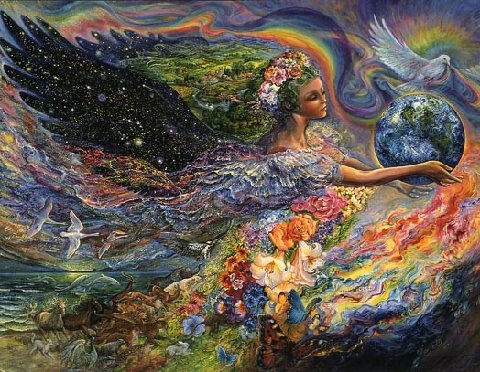 |
| Painting of a Mother Nature figure |
Women and the environment have gone
hand in hand for most of human civilization. Early societies often personified
nature as a woman in religious traditions like the Greek Gaia, who gave birth
to the Earth and the universe, and that still continues today with modern
Mother Nature. Women are commonly associated with manipulating the environment and
its resources for survival, like getting water and planting gardens to feed the
family. They make up 51% of agriculture workers worldwide, according to the United Nations Population Fund, and that varies from 50% in Latin America to
80% in sub-Saharan Africa, meaning they have a large impact. There’s even a
body of literature about it – ecofeminism!
 This means that women are the ones
most easily affected by environmental destruction and other environmental
issues like climate change. As the world has developed, women have had to do
more and more to stay afloat – walk farther for water, because local rivers
have dried up or been polluted, or struggle to replant a crop on land that’s
suffering from soil erosion or pesticide overuse. For example, female flower
workers in Colombia are exposed to 120+ chemicals per day, many of which are
illegal in first world countries, and in India women spend 4-5 hours per day looking
for firewood which, before the effect of deforestation, they would only have to
look every 4-5 days.
This means that women are the ones
most easily affected by environmental destruction and other environmental
issues like climate change. As the world has developed, women have had to do
more and more to stay afloat – walk farther for water, because local rivers
have dried up or been polluted, or struggle to replant a crop on land that’s
suffering from soil erosion or pesticide overuse. For example, female flower
workers in Colombia are exposed to 120+ chemicals per day, many of which are
illegal in first world countries, and in India women spend 4-5 hours per day looking
for firewood which, before the effect of deforestation, they would only have to
look every 4-5 days.
The connection between women and
the environment has been recognized by the UN through various meetings of the UN
Environment Programme focused on the role of women. The meetings have concluded
that women are essential to sustain the environment but that women worldwide
lack access to the resources necessary. Women are suffering the effects of
contaminated water and food, and passing it onto further generations through
breastfeeding and other natural causes without any knowledge of what to do
about it.
There are some strong cases where
women have been the main advocates for environmental sustainability and have
created real change. The Green Belt movement in Kenya started in 1977 with the
planting of 7 trees. The organizer was a woman, Wangari Maathai, who would go
onto win the Nobel Peace Prize for her efforts and over 51 million trees have
been planted since to slow the deforestation and soil erosion in Kenya while
also providing economic opportunity for women. Other examples include the Nine
Seeds Movement in India, which was start by women and advocates for organic
agriculture and the development of seed banks.
Through increased agricultural
education of practices like crop rotation women can continue to have a great
effect on sustaining the environment in a way that is healthy for both the
Earth and the growing population. Women have been undervalued in environmental efforts
and can have a huge impact if given the opportunities. The OECD has proven that women consume less than men and care more about the future of the environment,
and organizations should be doing more to nurture that care for the future.
Cia♀,
Charlie
Thank you for pointing out the connection between women and the environment, which is an interesting idea. Going back to your first paragraph about Gaia and mother nature, it is clear women are linked to nature in their capacity as mothers, e.g. caretakers. This also appears to be what women are doing in the actual sense today, they are taking care of the environment. The role of the mother or caretaker is often tied to a lot of emotion, and it is my impression that critics of environmentalism often deride this aspect. Much of the negative aspects about environmentalists I've heard have had to do with their lack of practicality and logic. The stereotype is the unknowingly hypocritical environmentalist who just really loves a natural world they don't know much about. This seems similar to the stereotype of women as much more emotional and less logical then men. I think this dual stereotype of the feminine environmentalist can get in the way of all of the very rational reasons to preserve the environment, another reason the struggles of women are connected to environmental struggles.
ReplyDelete